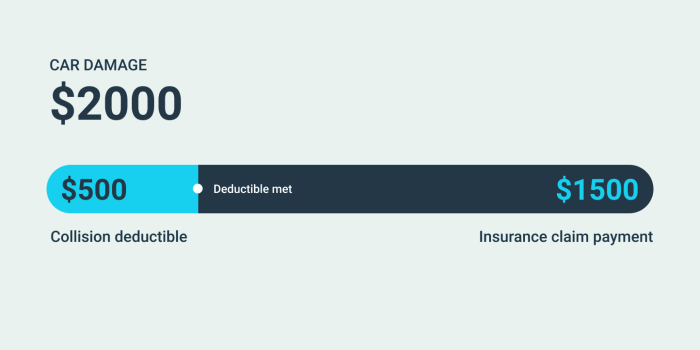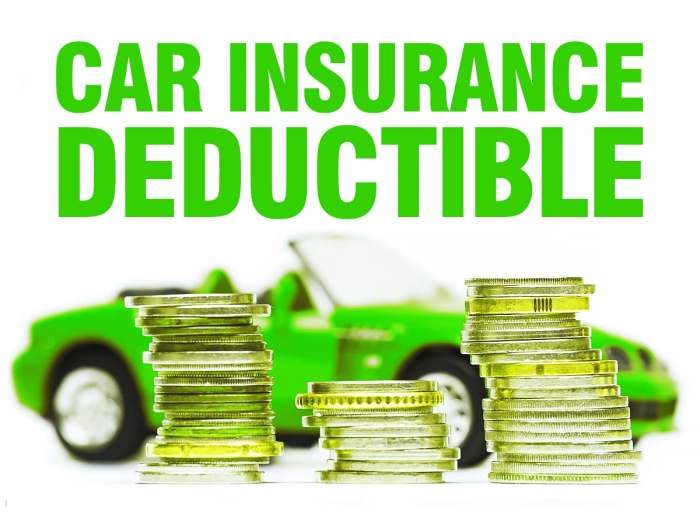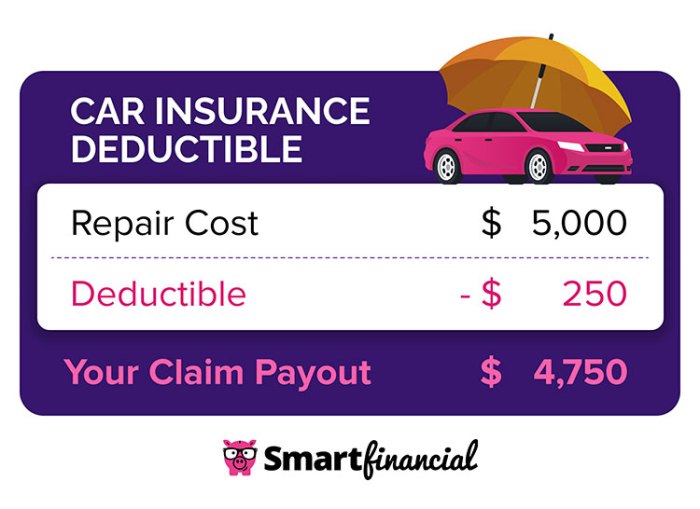How do I choose the right car insurance deductible? It’s a question that pops up when you’re shopping for car insurance or reviewing your current policy. The deductible is the amount you pay out of pocket before your insurance kicks in after an accident.
It might seem like a simple decision, but there’s more to it than meets the eye. Choosing the right deductible can significantly impact your premium costs and your financial burden after an accident.
There are a lot of factors to consider when choosing a deductible, including your financial situation, driving history, and the value of your car. A higher deductible usually means a lower premium, but it also means you’ll have to pay more out of pocket if you need to file a claim.
A lower deductible means a higher premium, but you’ll have less to pay out of pocket if you need to file a claim. Ultimately, the best deductible for you will depend on your individual circumstances and risk tolerance.
Understanding Deductibles

Your car insurance deductible is the amount of money you’ll pay out of pocket before your insurance company starts covering your claim. It’s like a down payment for your car repairs.Think of it this way: you’re essentially sharing the cost of your car insurance with your insurer.
By choosing a higher deductible, you agree to pay more upfront in the event of an accident, but in exchange, you’ll get a lower premium (the amount you pay monthly for your insurance).
Deductible Amounts and Premium Costs, How do I choose the right car insurance deductible?
The relationship between your deductible amount and your premium is pretty straightforward: the higher your deductible, the lower your premium. Here’s an example:Let’s say you’re considering two different deductibles for your car insurance:* $500 Deductible:This is a lower deductible, meaning you’ll pay less upfront if you need to file a claim.
However, you’ll likely pay a higher premium each month.
$1000 Deductible
This is a higher deductible, meaning you’ll pay more upfront if you need to file a claim. But, you’ll likely pay a lower premium each month.Choosing the right deductible depends on your individual circumstances and risk tolerance. If you’re comfortable paying more upfront in the event of an accident, you can save money on your monthly premium by choosing a higher deductible.
However, if you’re worried about being able to afford a large out-of-pocket expense, a lower deductible might be a better option.
Factors Influencing Deductible Choice
Choosing the right deductible is a key part of getting the car insurance that fits your needs. It’s like deciding how much risk you’re willing to take on. A higher deductible means you pay more out of pocket if you have an accident, but your premiums will be lower.
A lower deductible means you pay less out of pocket, but your premiums will be higher. So, how do you decide what’s right for you?
Financial Situation
Your financial situation is a big factor in choosing your deductible. If you have a lot of savings or a good emergency fund, you might be comfortable with a higher deductible. This is because you’ll have the money to cover the cost of repairs or a replacement vehicle if you need to.
On the other hand, if you’re on a tight budget, you might prefer a lower deductible, even if it means paying more in premiums.
Driving History
Your driving history can also play a role in your deductible choice. If you have a clean driving record, you might be able to get away with a higher deductible. This is because insurance companies view you as a lower risk, and they’re more likely to offer you lower premiums.
But if you have a history of accidents or traffic violations, you might want to consider a lower deductible. This will help you avoid a big out-of-pocket expense if you have another accident.
Vehicle Value
The value of your vehicle is another important factor to consider. If you have a newer or more expensive car, you might want to choose a lower deductible. This is because the cost of repairs or a replacement vehicle will be higher.
If you have an older or less expensive car, you might be able to get away with a higher deductible.
Deductibles and Claims

Now that you understand how deductibles work and what factors influence your choice, let’s dive into how deductibles affect your claims.
Deductibles and Claim Costs
Imagine you’re driving down the road and BAM! Someone runs a red light and crashes into your car. You’re shaken up but thankfully okay. Your car, however, needs some repairs. This is where your deductible comes into play.
Let’s say your car needs $2,000 worth of repairs. Here’s how your deductible affects your out-of-pocket expenses:
Scenario
You have a $500 deductible and file a claim with your insurance company. Your insurance company will pay the remaining amount, $1,500, after you pay your deductible.Here’s a table that shows how the deductible amount impacts your out-of-pocket cost for repairs:
| Deductible Amount | Insurance Pays | Out-of-Pocket Cost |
|---|---|---|
| $500 | $1,500 | $500 |
| $1,000 | $1,000 | $1,000 |
| $2,000 | $0 | $2,000 |
As you can see, the higher your deductible, the less your insurance company pays, but the more you have to pay out-of-pocket.
Premium Savings
It’s important to note that a higher deductible usually means lower premiums. This is because the insurance company is taking on less risk. So, while you might pay more upfront for repairs, you’ll save money on your monthly premiums.
Example
For example, let’s say you have a $500 deductible and pay $100 per month for car insurance. If you increase your deductible to $1,000, your monthly premium might drop to $80. This means you’ll save $20 per month, or $240 per year.Of course, the amount of premium savings will vary depending on your insurance company, your driving history, and other factors.
But in general, you can expect to save money on your premiums if you choose a higher deductible.It’s important to weigh the pros and cons of different deductible amounts and choose the one that best fits your budget and risk tolerance.
Deductible Considerations

Choosing the right deductible is a crucial part of your car insurance plan. You need to weigh the potential savings you’ll get with a higher deductible against the risk of having to pay more out of pocket if you need to file a claim.
It’s important to consider your financial situation and your risk tolerance.
Emergency Savings for High Deductibles
If you choose a high deductible, it’s essential to have enough emergency savings to cover it. This is because you’ll need to pay the deductible out of pocket before your insurance company starts covering the costs of repairs or replacement.
For example, if you have a $1,000 deductible and your car is damaged in an accident, you’ll need to pay the first $1,000 of repairs yourself. Having enough emergency savings will prevent you from having to take on debt or sell assets to cover the deductible.
Estimating Repair Costs
To determine the right deductible for you, it’s helpful to estimate the potential repair costs for different types of accidents. For example, if you live in a city with a lot of traffic, you may be more likely to be involved in a minor fender bender.
The repair costs for these accidents are typically lower than those for more severe accidents. However, if you live in a rural area with fewer cars on the road, you may be more likely to be involved in an accident with a large animal or in a severe weather event.
These types of accidents can result in significant damage to your car and high repair costs.
Negotiating Repair Costs
It’s important to know that you have the right to negotiate repair costs with your insurance company and the body shop. If you think the repair costs are too high, you can ask for a second opinion from another body shop.
You can also negotiate with your insurance company to see if they will pay for some of the repairs that are not covered by your policy.
Remember, you’re not obligated to accept the first estimate you receive.
It’s important to be assertive but polite when negotiating. If you’re not comfortable negotiating yourself, you can ask a friend or family member to help you.
Final Thoughts: How Do I Choose The Right Car Insurance Deductible?

Choosing the right car insurance deductible is a crucial decision that can impact your wallet in the long run. By understanding the factors involved, evaluating your financial situation, and weighing your risk tolerance, you can make an informed choice that aligns with your needs.
Remember, it’s not just about saving money on your premium, but also about being prepared for the unexpected. Having a clear understanding of your deductible can give you peace of mind knowing that you’re covered in case of an accident, while also helping you manage your financial risks effectively.
FAQ Overview
What happens if I choose a high deductible and don’t have enough money to cover it?
If you choose a high deductible and can’t afford to pay it, you might have to delay repairs or even go without them. This could lead to further damage to your car or put you in a dangerous situation.
How do I know if I’m paying too much for my car insurance premium?
You can compare quotes from different insurance companies to see if you’re getting a good deal. You can also ask your current insurance company for a review of your policy to see if there are any discounts or adjustments you’re eligible for.
What are some things I can do to lower my car insurance premium?
You can lower your premium by improving your driving record, taking a defensive driving course, installing safety features in your car, and bundling your car insurance with other policies, like homeowners or renters insurance.
